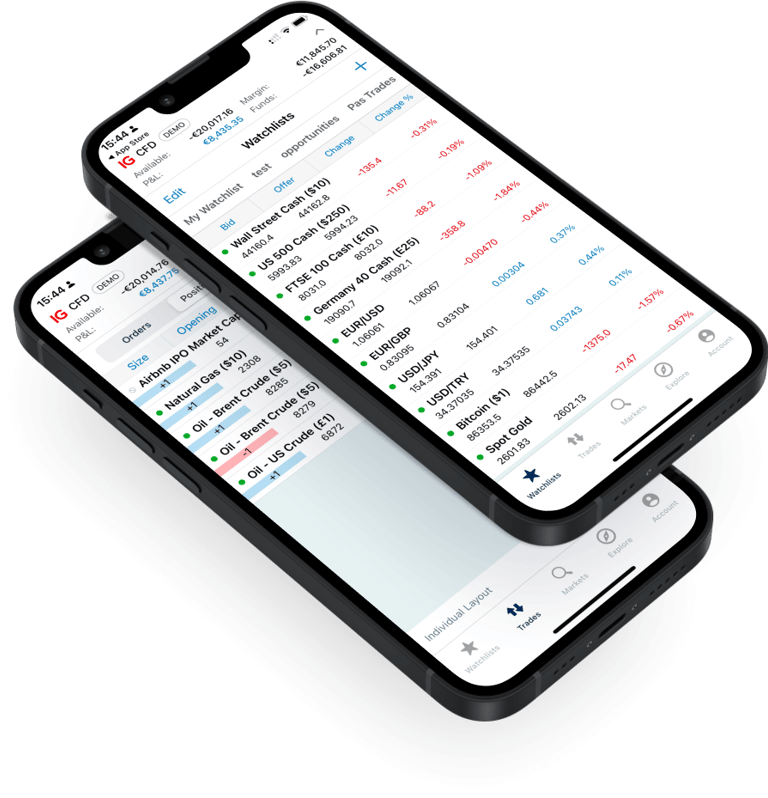

IG
Brief
Leading a team of UX/UI designers and researchers to create the future vision for IG’s mobile trading applications. My vision was to deliver the zoomed-out and composed experience of desktop trading in the mobile world.
During my time at IG I have developed a group of foundational UX approaches to best utilise and perform research for the diverse nature of traders and the specific complexities inherent in complex trading systems.
Due to the confidential nature of this position I am unable to share photos/images of the work I performed, which is a shame as it's some of my most ground-breaking design thinking.
Case Study
When I first came to IG they had a requirement for designers to view several hours of prior or current research a week. Once I started to perform this task it became apparent that IG had a wealth of historical research that wasn't being properly used. As I was in a stage where I had a lot of time for design thinking I ended up watching the entire back catalog of research videos and documented the data into observations, insights, and feedback.
Research Initiative
Seeing that the service designer and the research team had an initiative to create a better resource for understanding our users I decided to combine the documentation I had started into a strategy for a larger more usable tool.
Strategy
Using the archetypes (similar to personas) I worked with the team to identify the core goals of trading, specifying somewhat in the capabilities of the mobile experience.
Over several workshops we distilled this into 3 sequential core tasks
Exposing Opportunities
Rather than the original 'Finding Opportunities' this rewording set out the premise that there is little time on mobile to do the standard screening for opportunities and we should personalise and tailor the application to help expose opportunities for the user, based on their trading strategy, bringing the core analysis into the first screens for the user.
Executing Trades
One of the core features of a successful trading application is the fastest and best price execution of trades from the point of finding an opportunity a customer wants to trade on. This can be the technical execution of the backend but also the perceived execution of a trader. If they want to trade an opportunity then it must feel like there is no friction in the way.
Controlling Positions
A trader always has a position, whether it's in saving in cash, or on a trading platform as equity. What are the core principles of positions from sizing, margin, exposure, entry, and exits.
Building the new research tool
The outcome of this work was realising a new database, using the airtable as the best-selected tool for research. At the top level, we put in the three goals of trading. We then proceeded to transcribe all existing research and tag them as observations, insights, and feedback. We then sub-labeled these into a manageable set of labels under each goal to better query the upcoming research database tool.
We then pulled a committee of experts from different parts of the business; front-end developers, back-end developers, business analysts, researchers, and designers. We had weekly meetings to agree upon each insight's category and value and sorted them in the database as such.
I also built a new framework using Bayesian type theory for estimating the efficacy of a design change as it has been shown in various studies to vastly increase the accuracy of estimation to real world outcomes.
Conclusion
Once all the work had been completed collating the existing research and pulling in all new research. We had a new design research tool with many benefits.
One of the biggest problems in financial design is that it's a very complex subject that takes years to learn, and it takes years to learn how to trade and understand markets specifically. What we found is that this often turned into unconscious design mistakes by designers as they haven't the practical experience of trading to identify some glaring design mistakes, for example, changing asset lists from a spreadsheet-based look to a card-based one.
What this tool enabled was every designer to quickly research the research history of the area they were going to work on and understand the provenance, all the user feedback, and the research observations that had been made so they were better equipped to execute a design that would be better.
Another byproduct of the research tool was that in having weekly discussions to sort research into a fast and useable tool we were having in-depth discussions about all the research and the areas of the application, so everyone's knowledge became significantly better as area expertise and understanding was shared.
Due to this project, for the first time in company history, a designer-led initiative was granted 20% of developer time to work on building and releasing the work that was realised from the research tool.
What I gained from this role
During my time at IG I developed a group of foundational UX approaches to best create design for the diverse nature of traders and the specific complexities inherent in complex trading systems.
These core principles were compounded by research into the psychological nature of trading, understanding research into the dopaminergic system, insular cortex (fear centers), and the possibility of invoking more benevolent neurotransmitters and hormones such as Oxytocin. Another area, more psychologically based, is the wide array of inherent biases in trading, I mapped out classic trading situations and the biases attributed to the behaviours.
During my work at IG, and since, I have spent a lot of time investigating the neuroscience and psychology of trading and still plan to complete a new design approach specifically for trading based on this.
I built a new and innovative way to screen and expose opportunities on mobile which is still to be implemented in any platform and have built many new concepts on personalisation, execution, and position control.


